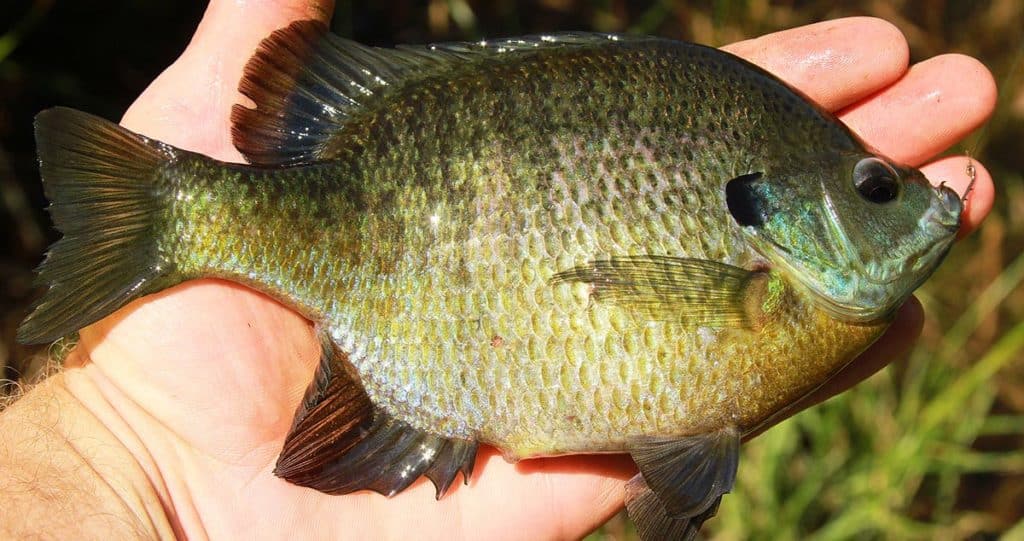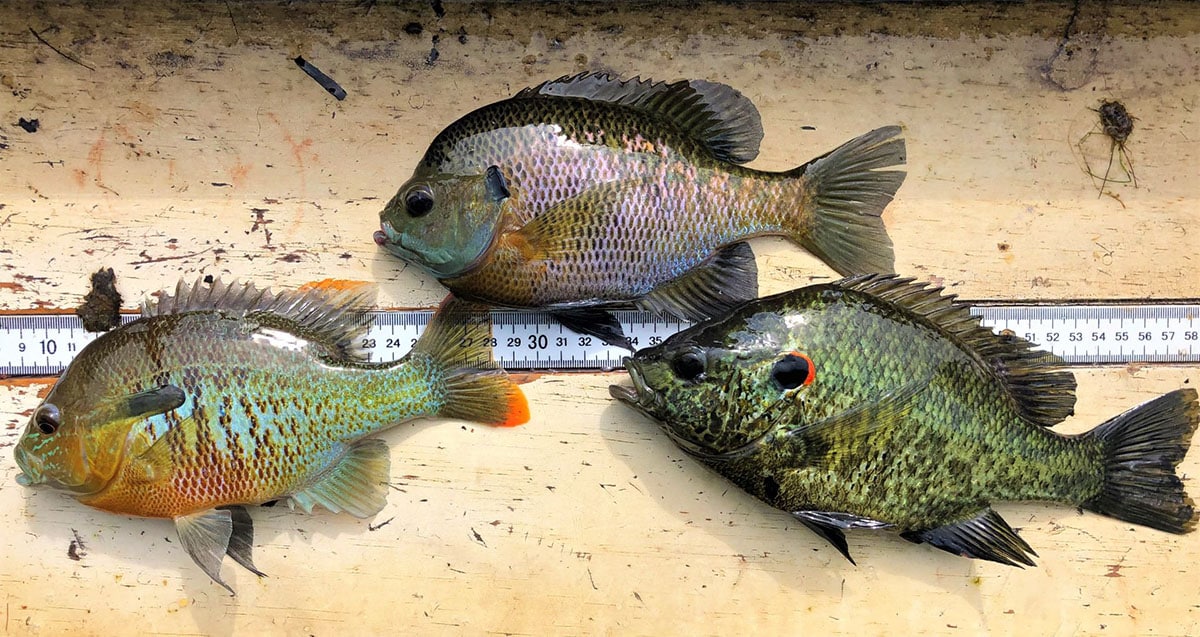Georgia’s Best Bream Fishing North to South
JUMP TO: Northwest Georgia | Northeast Georgia | Central Georgia | Southwest Georgia | Southeast Georgia | Farm Pond Fishing
Georgia offers fantastic bream fishing much of the year, and chances are you can likely find plenty of great opportunities within a short drive of where you live.
In this article, we’re going to take a look at the best public waters to catch bream in Georgia from North to South, with a lot of great insight from state fisheries biologists.
Northwest Georgia
If you’re looking to fish in the Northwest part of Georgia, DNR fisheries biologist Jim Hakala recommends Rocky Mountain Public Fishing Area (PFA) and the lakes at James H. “Sloppy” Floyd State Park.
Rocky Mountain PFA
The Rocky Mountain PFA consists of three lakes totaling 559 acres of water. Like most of Georgia’s public fishing areas, the lakes are fertilized to improve fish abundance and growth.
“The bream fishing is very good at Rocky Mountain PFA,” said Hakala. “Several fish feeders are in operation at each lake, and these areas can be good places to target all summer. The best bream fishing is April through June, when the fish are actively spawning. The redear sunfish will bed in April and the bluegill in May through summer.”
James H. “Sloppy” Floyd State Park Lakes
Bank access around the two lakes at James H. “Sloppy” Floyd State Park is excellent, and both boast good bream populations. Again, bream fishing is best from April through June.
“While there are plenty of shallow areas that bream will visibly bed, some of the larger bream will bed offshore in 4 to 8 ft. of water,” Hakala said. “These fish are best pursued from a boat using a cricket rigged on a drop-shot type presentation. Cast the cricket out and slowly drag it along the bottom. If pulled through a colony of bedding bream, a bite is sure to follow.”

Northeast Georgia
If you’re in the northeast corner of the state, then DNR fisheries biologist Hunter Roop recommends Lake Tugalo or Lake Marbury.
Lake Tugalo
Lake Tugalo is a beautiful 600-acre lake formed by the Tallulah and Chattooga rivers. The steep canyon walls and small waterfalls that surround the forested shoreline create unusual scenic beauty. To maintain the pristine aspects of this small reservoir, outboard motors are restricted to 25 horsepower. In addition to a quality bream fishery consisting of large redbreast, bluegill and shellcrackers, Tugalo also provides seasonal opportunities to catch white bass and channel catfish.
Roop offers this advice for those looking to catch a limit of big bream:
“Redbreast and bluegill in the 6-inch and 1/4 lb range are very common around downed trees and stream outlets in the upper half of the lake. Redear sunfish are less abundant, but trophies weighing up to 3 lb are caught each year along the steep rocky banks near the South Carolina boat ramp.”
“Crickets and small spinners are effective baits for redbreast and bluegill. Cast around shallow water structure that is located in the small pockets and backs of coves. Fishing with red wigglers on slightly deeper rocky bottoms on the main shoreline is a more effective approach for targeting trophy shellcrackers.”
“Fallen trees are abundant along the rugged, undeveloped shoreline of Lake Tugalo. The submerged tree trunks and branches provide a perfect hideout for bream that should be targeted by bream anglers. In addition, good numbers of bream reside in the many small creek mouths that drain into the lake.”
Lake Marbury
Lake Marbury is a beautiful reservoir in Winder, Georgia just northeast of Atlanta and within Fort Yargo State Park. The lake is 260-acres, and the protected shoreline and stable water conditions create great fishing opportunities for state park visitors.
Lots of downed trees, sand and rock shorelines, and vegetated shallows create a healthy mix of locations to target for quality bream (mainly bluegill and redbreast).
You can use a variety of baits including crickets, worms, mealworms, or even bread fixed to small j-hooks and a bobber. Targeting blowdowns and riprap will be your best bet to catch bream on this lake, and there is plenty of cover to target. The deeper ledges holding sand or rock tend to hold the larger shellcrackers, so fish deeper for these bigger fish.
Rentals for self-propelled watercraft are available for those that would like to venture out from shore.

Central Georgia
If central Georgia is where you call home, then Georgia DNR fisheries biologist Steve Schleiger recommends Lake Jackson and the Savannah River around Augusta.
Savannah River
“The Savannah River around Augusta is our top pick on the east side of Region 3, including the Augusta Canal,” said Schleigher. “One of the best locations is upstream of the Stevens Creek Dam where the river is wide and loaded with aquatic vegetation, especially in a shallow, stumpy channel on the South Carolina side commonly referred to as the “Deepstep” area.”
The bluegill fishing is fantastic but the shellcracker fishing is what really sets this place apart. This is an excellent area for trophy redear fishing, routinely producing two-pound fish, plus the South Carolina state record of 5 lb. 7.5 oz was caught nearby as well.
Fishing with small red wigglers or beetle-spins around the edges of the vegetation or stumps are very effective tactics in this area. As always with bream fishing, focus on the full moons, especially in June.
Lake Jackson
Lake Jackson is one of middle Georgia’s better bream lakes. Bluegill and redbreast sunfish typically reach 5 to 7 inches, while redear sunfish are numerous and much larger.
“Recent sampling data suggest that anglers can expect high catches of redear sunfish in 2022,” said Schleigher. “Anglers should find bream fishing comparable with previous years with redear sunfish being the dominant catch. Anglers will find the average-sized redear sunfish near 8 inches. Target blow downs and weed lines for larger bream.”

Southwest Georgia
In the southwestern part of the state, Georgia DNR fisheries biologist Emilia Omerberg recommends House Pond at Silver Lake PFA and portions of the Flint River for bream fishing opportunities.
House Pond
“I would say that in general southwest Georgia has a better redear sunfish and crappie fishing than bluegill fishing,” said Omerberg. “But if I had to pick a few, I would start with House Pond at Silver Lake Public Fishing Area. House Pond is specifically managed as a trophy bluegill pond. It won’t be great bream fishing in the late fall and winter, but summer would be a great time to fish it.”
The pond does have special regulations that anglers should be aware of. Its only open Thursday through Saturday and closed Sunday through Wednesday. You are only allowed to keep five bream of any kind, and they must be longer than 8 inches. Also, you can keep one hybrid striped bass over 18 inches.
Flint River
Another good spot for bluegill fishing is the lower Flint River below the Warwick dam all the way to Lake Seminole.
“Focus your efforts on mouths of creeks and slower moving waters,” recommends Omerberg. “Crickets, worms, and beetle spins are your best bet. Just remember that bluegill have relatively small mouths so be sure to use bait that is appropriately sized.”

Southeast Georgia
In southeast Georgia, the best public bream fishing opportunities center around rivers, particularly the Satilla and Ogeechee Rivers.
Satilla River
The Satilla River flows 260 miles from Benn Hill County to the Atlantic Ocean south of Brunswick. It is considered to be one of the most beautiful rivers in south Georgia, and a premier redbreast sunfish fishing destination.
For those targeting redbreast sunfish, the Satilla River provides one of the best opportunities to catch fish over a pound. Anglers should concentrate their efforts around woody cover in the main river channel using crickets and worms under bobbers or on the bottom. Once water temperatures warm into the 70s, try using artificial lures like beetle spins and rooster tails. Fly fishing can also be an effective tactic.
If it’s bluegill you’re after, anglers can expect fish in the 6 to 8 inch range. Anglers should stick to crickets and worms in the oxbow lakes and beaver ponds off the main river channel. The bluegill fishing can be especially good in the oxbow lakes around the Burnt Fort area.
Ogeechee River
The Ogeechee River begins in Greene County and flows into the Atlantic Ocean south of Savannah. It’s one of Georgia’s few remaining free-flowing streams, and provides excellent bream fishing opportunities. Public access points are somewhat limited, but the scenery and fishing action make it worth the effort.
Fishing action on the Ogeechee typically picks up in the spring when water levels drop below 6 feet at the USGS gauges in Eden, and can remain good throughout the summer months depending on water levels and water temperature.
Redbreast sunfish are the most sought after species in the Ogeechee River, with peak action occurring April through June. Look for deep holes along the outside bends of the main river channel. For your best chances at filling up a stringer, use the same bait and techniques you would for the Satilla River discussed above.
Bluegill and redear sunfish fishing can be good in the Ogeechee River as well, starting in late April and continuing throughout summer while the fish are bedding. Like the Satilla River, the best bluegill fishing will be found in still water off the main river channel. Crickets and worms should provide the best results.
Farm Pond Bream Fishing
No matter where you live in Georgia, some of the best bream fishing can be found in local farm ponds.
“It’s hard to beat bream fishing in these small, typically unmanaged impoundments,” said fisheries biologist Hunter Roop. “Bass tend to get crowded and quickly feed on small bream — bluegill, redbreast, and redear sunfish, mainly. While the bass will inevitably be small and underweight due to high competition among other bass, the bream that successfully escape the gape of the undersized bucketmouths have huge growth potential.”
“I enjoy fly fishing for bream in farm ponds because the ponds are typically shallow throughout and the bream are eager to try anything that looks like an easy meal,” continued Roop. “Small poppers, ants, beetles, and mayfly dun imitations are perfect presentations that will bring fish after fish to hand and offer exciting topwater action. I like to target any wood or small pockets created by farm pond vegetation like rushes, cattails, or pondweed.”
Summary
It’s hard to beat a day of catching fish, and Georgia anglers are fortunate to have excellent bream fishing opportunities all across the state at their disposal. So the next time you’re looking for a place to get out and wet a line, give one of these ten lakes and streams a try. Even if you don’t come home with a stringer full of big bluegill, it still beats about anything else you could be doing!

